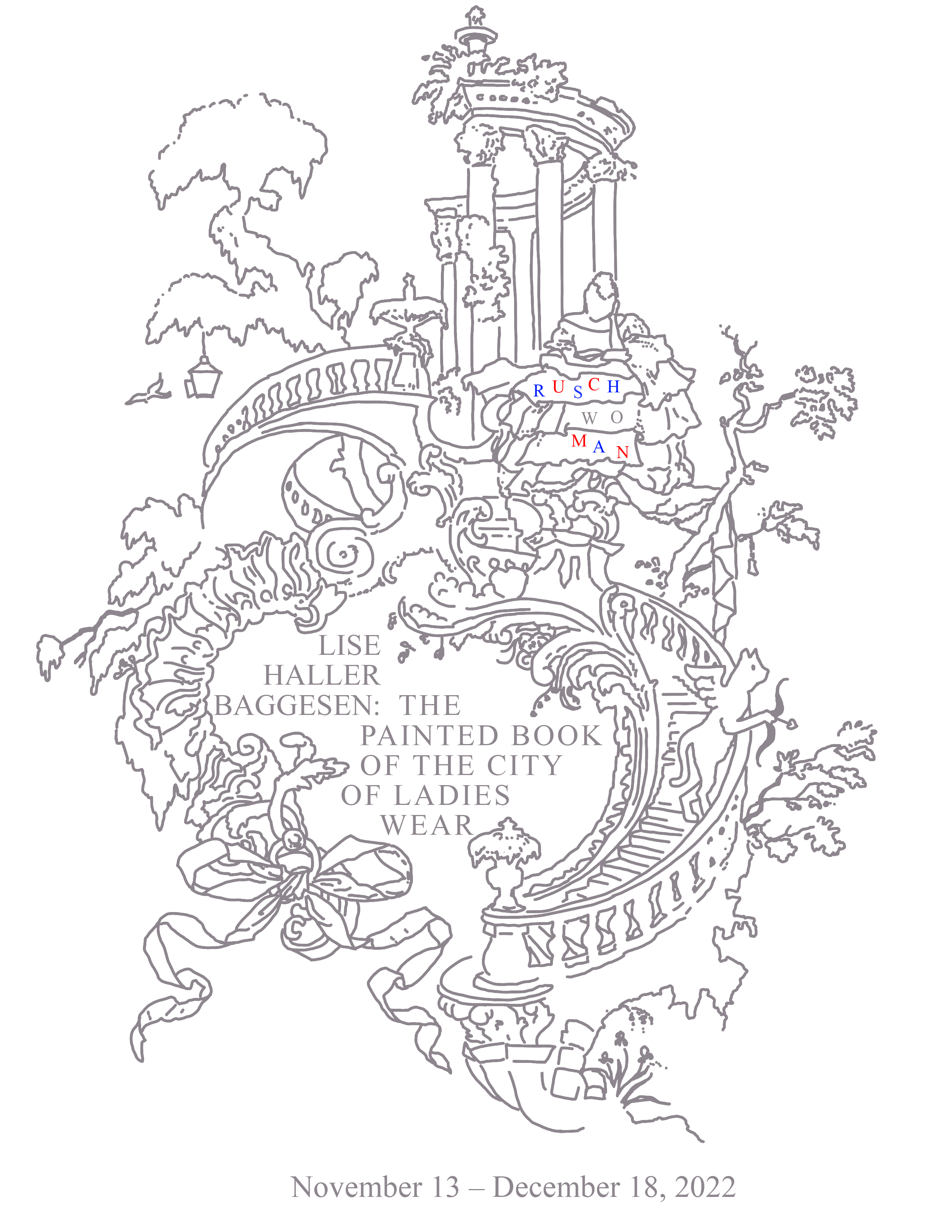E
R
I
C
R
U
S
C
H


M
A
N
E
R
I
C
R
U
S
C
H


M
A
N

 Lise Haller Baggesen, WIP [WHITE DUCK RABBIT], 2021
Lise Haller Baggesen, WIP [WHITE DUCK RABBIT], 2021
Lise Haller Baggesen:
The Painted Book of the City of Ladies Wear
RUSCHWOMAN
2100 S. Marshall Blvd., Suite 105
Chicago, IL 60623
November 13 – December 18, 2022
Opening reception: Sunday, November 13, 3–6PM
Following the opening, gallery hours are available by appointment only.
Please contact thewaves@ruschwoman.blue to make arrangements
to visit RUSCHWOMAN during the run of the exhibition.
You have come to ask me the relation of dressmaking to art.[1]
A society can be so stone-hard
That it fuses into a block
A people can be so bone-hard
That life goes into shock
And the heart is all in shadow
And the heart has almost stopped
Till some begin to build
A city as soft as a body [2]
This city-within-the-city provided necessary refuge for dreamers, artists, idlers, faggots, communists,
lady lovers, and all others determined to fashion a life not brutally constrained by the color line, not
broken by servitude, not cowed by white violence, not dominated by a man. [3]
Girded in courage and anticipatory of wild passion, RUSCHWOMAN announces her forthcoming solo exhibition with
maven of studio arts and letters Lise Haller Baggesen. The Painted Book of the City of Ladies Wear follows on
Baggesen’s inclusion in the 2021 group exhibition The Red Wedding at the Irving Park Ruschman location, and
certain curiosities are further expounded in this installation of new works: what if the best painting you see
this year is arrayed across a homemade prom gown? And in further proposition, the painting gathers and ruffles
into a tent à la Magiciens de la Terre, circa 1989—couture cradle of civilization—a birthday party backyard
bouncy castle kind of architecture—a levitating fairy godmother canopy last spotted in Agnes Varda’s 2015 Les
3 boutons—pass through Tchaikovsky Mother Ginger curtained skirts into a lengthy gallery tunnel (birth) canal.
The flâneuse’s promenade, the dandy’s arcade, and the 1990s pop-punk aesthete’s now obsolete shopping mall all
converge as architectural hauntings over an elaborate window display-cum-island of forgotten dreams adrift in
the witchy swamps of RUSCHWOMAN’s program.
Interrogating the part of textile in the traditions of painting finds Baggesen drawing the medium par excellence
into close range of tailoring, dressmaking, and fashion styling. The pattern panels of a dress awaiting assembly
become supports for a rush of highly chromatic, gestural abstractions. Baggesen proposes a categorical dissent
from painting’s hardened machismo, preferring instead a political stance comprising the limp (like delicate
tissue silks or some wrists), crushed (like disco velvet), fallen, and languid. Such positionalities are not
without precedent, but as of yet have resisted (or perhaps been prevented from) coalescing into an organized
discourse that draws together vestigial commonalities from post-minimalist, expanded-field painters such as
Sam Gilliam and Lynda Benglis, architectural (and by extension social) reimaginings like Faith Wilding’s Womb
Room, 1972, and perhaps even more transgressively, a fiercely liberatory reclamation of the padded rooms and
corresponding restraining garbs that characterize the aesthetics and functions of a hysterical diagnosis forced
upon female populations throughout the lifespan of chauvinistic psychological sciences.
The softening city that Baggesen erects is constructed with the painted gesture as a basic building unit, one in
which the possibilities of person and place meld together into an always hybridized, more-than-individual
sociality. A moment redolent of the collapse of fashion modeling and High Modernism captured in Cecil Beaton’s
1951 photograph of Dior and Pollock for Vogue. Stains, flurries of marks, impasto, and flirtatious interactions
with found prints are assembled into compositional fields mapped across bodices, skirts, puffed sleeves, bonnets,
and other paraphernalia. An open question floats about these hand-painted couture items: are they costumes?
Uniforms? Props? Daily dress? Utility wear? Riot gear? Club kid nostalgia?
The ready reply is that these are first and foremost paintings. And in their convulsive forms, contingent upon
either body or architecture, they serve as revealing measures for precisely the extent to which gender and sex
and desire and aesthetics and the class systems that mobilize and regulate such categories are situated into the
visual cultural field. Lavish and punk like a Vivienne Westwood, Baggesen melds the boutique with a battle
barracks from which a luscious pleasure activism on behalf of women, femmes, mothers, daughters, witches, crones,
dreamers, artists, and lady lovers may be waged. Indulgent and outraged, Baggesen’s sumptuous dressing room is an
expansion on the interior life spanning girlhood into womanhood; her most recent tableau signal back to Baggesen’s
Refuseniks, Lipstick Brutalisms, and Mothernism moms, in an intergenerational assembly haunted by suffragettes,
Womanhouse avant garde, and other ghosts of feminisms past.
Accompanying the (un-) wearables are painting-cum-makeup palettes that have been translated into a bouquet of
loosely defined and residual protest signs. Lilting lyric fragments and heartfelt declarations are inscribed
into painting surfaces that more often than not glimmer with Tiepolo-tinged cotton candy cloudscapes dusted in
shimmer powders and highlighters. If there is a milieu to which Baggesen’s studio work adheres, it is cosmetic
warpaint adorning a futurism edging toward cultural collapse.
What will you wear to the apocalypse? Fantasy fashions and dystopian science fictions have long pervaded in
Baggesen’s research, so much so that deliberating on the styles one might wear while the world expires deepens
from superficiality to a crucial ethics, one that acts upon the troubled veracity of appearances. Picking up the
thread, so to speak, from Sonia Delaunay’s bespoke Modernist ensembles, to the Parangolés of Brazilian Hélio
Oiticica, Louise Bourgeois’ clothes rack installations, Andrea Zittel’s A-Z Uniforms project, the Victoria &
Albert’s landmark David Bowie Is exhibition in 2013, Nick Cave’s Soundsuits, Lily van der Stokker’s prints for
couturiers Viktor & Rolf, Palais Galliera’s 2018 Margiela retrospective, Lucy McKenzie’s clothing brand Atelier
E.B., in collaboration with Beca Lipscombe, Walter van Beirendonck’s Antwerp boutique in the early 2000s, and at
close range, his partner Dirk van Saene’s hand-painted dresses are just some of the contemporary projects that
serve as context for Baggesen’s exploration of the wearable as an active unit within a field of sensuously
material and lively intellectual operations.
The installation Baggesen has prepared for RUSCHWOMAN crosses creamy pastel satin gowns in Watteau paintings
with the resplendent horror of Mad Max Thunderdome antics, all readied for consumption in a liminal wonderland
between haute couture and art market capitalism. Says the artist, “To me this body of work is a very American
beauty -- like if Kenneth Noland went to prom -- inscribing/saturating this polyester satin with a kind of
colourfield brushstroke, the river is oil and the boat is oil.” Undulating dance steps guide these painted
dresses into-and-through all of the contradictions bound up in the worlds to which they are oriented. Coquettish
and brazen, voluminous and mythic, these painting wearable hybrids are in movement toward a world of always
already pluralism that exceeds the human, the patriarchy, and the present day strictures of capital, looking
outward toward nascent high femme ecologies in which to thrive.
Christine de Pizan penned The Book of the City of Ladies in 1405 after she was visited by a grouping of three
shimmering apparitions, ladies who she said comforted her in her pain by offering a vision by which a future
feminist utopia might be structured, one built upon virtues demonstrated by a pantheon of goddesses, literary
heroines, and “princesses, great ladies, women of the middle and lower classes, who had graciously told me of
their most private and intimate thoughts.” The luminous display of disembodied paintings on dresses that Lise
Baggesen provides us functions likewise; they carry with them all sorts of historical legacies and many of the
female characters who have populated the artist’s prior bodies of work. Here, she has made a place for them to
reside, from which to practice their magics that would see the world before them turn soft.
Lise Haller Baggesen (1969) is a Danish-born,
Amsterdam-raised, Chicago-based, interdisciplinary artist. Her hybrid practice includes writing, installation,
performative, sartorial, and textile-based work. Her book and multi-media installation Mothernism (2013-) toured
extensively, staking out the “Mother-shaped Hole in Contemporary Art” at The Poor Farm (WI), The Contemporary
Austin (TX), VOX Populi (PA), A.I.R. Gallery(NY) and spawned the international symposia The Mothernists.
refuseniks (2017) materialized at the residency “Body as Site” at The Banff Centre (AB). The portable and
wearable TAZ (Temporary Autonomous Zones) visited The Suburban (WI) Le Confort Moderne (F) 6018 North (IL) and
most recently the MCA Chicago (2021). HATORADE RETROGRADE (2016) debuted at Threewalls (IL) with an Artforum
Critic’s Pick: “As if the world had fallen apart but the party persisted, this moody boutique peddles a
survivalist feminism that cuts across styles, layering glam with grunge, pop with punk.” HATORADE RETROGRADE:
The Musical (2019) was produced and presented by Southern Exposure (CA) and Gallery 400, University of Illinois
at Chicago (IL). It was reviewed in Art Practical: “blending 1960s counterculture nostalgia and futuristic
fiction, the performance imploded the boundaries between speculative narrative and the surreal elements of
reality.” Upcoming shows for summer 2023 include APOCALYPSTICK at Le Confort Moderne, Poitiers (F) and A Space
Where Your Voices Can Live for Malmö Konstmuseum (S)/Roskilde Festival (DK)
____________________
[1] Jeanne Lanvin. The Christian Science Monitor. October 1, 1930. Print, p. 8.
[2] Inger Christensen. “ LOGOS: ACTION, symmetries 8” from the poetry collection IT, 1969. English translation
by Susanna Nied, 2006.
[3] Saidiya Hartman. Wayward Lives, Beautiful Experiments: Intimate Histories of Riotous Black Girls, Troublesome
men, and Queer Radicals. New York: W. W. Norton and Company, 2019. Print, p. 300.
Lise Haller Baggesen, The Painted Book of the City of Ladies Wear, 2022, Installation View
Lise Haller Baggesen, The Painted Book of the City of Ladies Wear, 2022, Installation View
Lise Haller Baggesen, The Painted Book of the City of Ladies Wear, 2022, Installation View
Lise Haller Baggesen, The Painted Book of the City of Ladies Wear, 2022, Installation View
Lise Haller Baggesen, [XXX], 2020/2022, Oil on canvas with wooden dowel
Lise Haller Baggesen, [SEMI[ER]OTICS], 2020/2022, Oil on canvas
Lise Haller Baggesen, [THE BOAT IS OIL THE RIVER IS OIL], 2020/2022, Oil on polyester satin
Lise Haller Baggesen, [THE BOAT IS OIL THE RIVER IS OIL], 2020/2022, Oil on polyester satin, Detail View
Lise Haller Baggesen, The Painted Book of the City of Ladies Wear, 2022, Installation View
Lise Haller Baggesen, [WHITE DUCK/RABBIT], 2020/2022, Oil on polyester satin
Lise Haller Baggesen, The Painted Book of the City of Ladies Wear, 2022, Installation View
Lise Haller Baggesen, [LAVENDER GLITCH], 2020/2022, Oil on polyester satin
Lise Haller Baggesen, The Painted Book of the City of Ladies Wear, 2022, Installation View
Lise Haller Baggesen, [24 HR TARDY PEOPLE], 2020/2022, Oil on polyester satin, Detail View
Lise Haller Baggesen, The Painted Book of the City of Ladies Wear, 2022, Installation View
Lise Haller Baggesen, [THE SHI-ZASSLE], 2020/2022, Oil on canvas with wooden dowel
Lise Haller Baggesen, The Painted Book of the City of Ladies Wear, 2022, Installation View
Lise Haller Baggesen, The Painted Book of the City of Ladies Wear, 2022, Installation View
Lise Haller Baggesen, The Painted Book of the City of Ladies Wear, 2022, Installation View
Lise Haller Baggesen, [BALL OF YAWN], 2020/2022, Oil on cotton
Lise Haller Baggesen, [POCKET SCIENCE], 2020/2022, Oil on polyester satin
Lise Haller Baggesen, [ICE BLINK LUCK], 2020/2022, Oil on cotton
Lise Haller Baggesen, [BALL OF YAWN], 2020/2022, Oil on canvas with wooden dowel
Lise Haller Baggesen, [BALL OF YAWN], 2020/2022, Oil on cotton, Detail View
Lise Haller Baggesen, [BALL OF YAWN], 2020/2022, Oil on silk and polyester, Detail View
Lise Haller Baggesen, The Painted Book of the City of Ladies Wear, 2022, Installation View
Lise Haller Baggesen, The Painted Book of the City of Ladies Wear, 2022, Installation View
Lise Haller Baggesen, The Painted Book of the City of Ladies Wear, 2022, Installation View
Lise Haller Baggesen, [SCHOOL'S OUT 4 EVA], 20202022, Oil on polyester satin
Lise Haller Baggesen, [BO/WO/W/OW], 2020/2022, Oil on canvas with wooden dowel
Lise Haller Baggesen, The Painted Book of the City of Ladies Wear, 2022, Installation View
Lise Haller Baggesen, [EGGS MARK THE SPOT], 2020/2022, Oil on canvas
Lise Haller Baggesen, [ALWAYS RUNNING DOWN HALLWAYS], 2020/2022, Oil on polyester satin
Lise Haller Baggesen, [AXE TO GRIND], 2020/2022, Oil on polyester satin
Lise Haller Baggesen, [BURNING RUBBER RAINBOW, 2020/2022, Oil and glitter on canvas
Lise Haller Baggesen, [KARMA CAMO], 2020/2022, Oil and glitter on canvas
Lise Haller Baggesen, The Painted Book of the City of Ladies Wear, 2022, Installation View
Lise Haller Baggesen, The Painted Book of the City of Ladies Wear, 2022, Installation View
Lise Haller Baggesen, [DO THE RICH NEED THE POOR TO BE RICH?], 2020/2022, Oil on canvas with wooden dowel
Lise Haller Baggesen, The Painted Book of the City of Ladies Wear, 2022, Installation View
Lise Haller Baggesen, [ALWAYS RUNNING DOWN HALLWAYS], 2020/2022, Oil on polyester satin, Detail View
Lise Haller Baggesen, The Painted Book of the City of Ladies Wear, 2022, Installation View